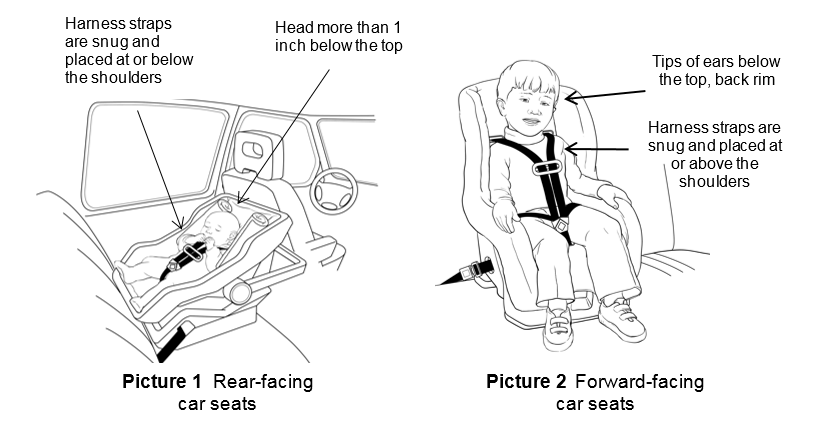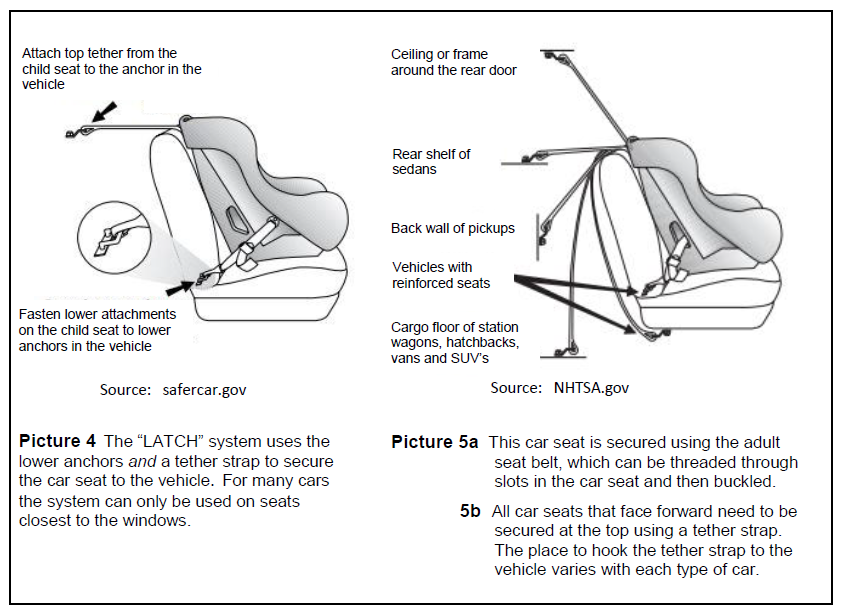Child Passenger Safety: Car Seats and Booster Seats
Primary Care Pediatrics
Looking for services or physicians who can help treat this condition?

Young children are safest riding in a car seat or booster seat in the back seat of the car. There are many choices on the market:
- Rear-facing only
- Convertible
- 3-in-1
- Combination
Some car seats face only one direction while others can change direction. Knowing which seat to use and when to change to another can be confusing. The safest decision (best practice) is based on a combination of recommendations from the American Academy of Pediatrics (AAP), the National Highway Traffic Safety Administration (NHTSA) and Ohio Law. It is also important to know the guidelines specific to each model of car seat. These can be found in the owner’s manual.
Ohio law requires that children ride in a car seat or booster until the child is 8 years old or 4’ (feet) 9” (inches) or 145 cm (centimeters) tall.
Best Practices Guidelines
| Child's Age | Type of Car Seat | Best Practice Recommendation |
|---|---|---|
| Birth to 12 months |
Rear-facing only* |
Under age 1 must ride rear-facing. |
| 12 to 23 months | Convertible 3-in-1 |
Stay rear-facing until at least age 2, unless child is above the height or weight limit of the car seat. |
| 2 to 3 years | Convertible 3-in-1 Combination |
Stay rear-facing as long as possible. If above height or weight limit of rear-facing car seat, switch direction to face forward, or change to a different car seat. |
| 4 to 7 years | Convertible 3-in-1 Combination Booster |
Stay in a car seat facing forward for as long as possible before switching to a booster. Can use a booster seat if above height or weight limit of the car seat. |
| 8 to 12 years | 3-in-1 Booster Adult seat belt |
Use a booster until: 1) Child’s back and bottom are flat against seat of car. 2) Shoulder belt fits across the middle of the shoulder and chest. 3) Lap belt fits low across the hips. 4) Knees bend at the edge of the seat of the car. 5) Can sit with feet on the floor for the whole trip. Must be “yes” to all “5 steps” to use the adult seat belt. Ohio law allows the use of an adult seat belt at age 8. All children under age 13 should ride in the back seat. |
Height Guidelines Common to Car Seats
The height limit in all car seat models is gauged by observing where the child’s head and shoulders rest in the car seat.
The height of the child’s head should be (Pictures 1 and 2):
- in car seats that face the back of the car, 1” or more below the back top edge of the car seat
- in car seats that face the front of the car, the head can be higher than the back top edge of a car seat but the tops of the child’s ears need to be below the top edge.
The harness straps need to be (Pictures 1 and 2):
- in car seats that face the back of the car, at or below the level of the shoulders
- in car seats that face the front of the car, at or above the level of the shoulders

Where Your Child Should Ride and Airbag Safety
Children under the age of 13 should ride in the back seat. Sitting in the front seat could cause serious injury if the airbag goes off (inflates).
- If a child must ride in the front seat for any reason, the front seat air bag should be OFF, the car seat or booster needs to be secured and the seat pushed back as far as possible.
- Never place a rear-facing child in the front seat of a vehicle unless the front air bag can be switched OFF manually (by hand).
How to Adjust the Harness Straps and Headrest
Harness straps give the best protection from injury in a crash. They are raised and refitted as the child grows. The harness straps should always be snug.
 In colder weather, always remove the child’s coat or puffy outerwear (snowsuit) before checking the fit and readjusting the harness straps.
In colder weather, always remove the child’s coat or puffy outerwear (snowsuit) before checking the fit and readjusting the harness straps.
- To make sure that the harness is tight enough, do the “pinch test” (Picture 3). When the child is sitting in the car seat, put your thumb and first finger on the strap at the child’s collarbone. Try to pinch the strap. If you can pinch a fold, the harness is too loose and should be tightened more. If your fingers slide off, it is tight enough.
- Some car seats let the headrest be raised so that the back of the car seat can become taller. The head rest needs to be at the right level for the child’s head (Picture 2, page 2).
- Make any adjustments before putting (installing) the seat in the car.
How to Install the Car Seat
Both the owner’s manual of the vehicle and the car seat manual need to be used to know how to install a car seat properly.
- The car seat needs to be installed at the correct angle. A rear-facing car seat needs to be tilted as far back as the car seat allows (Picture 1). A forward-facing car seat is always in the upright position (Picture 2). The owner’s manual will show the correct position.

- The car seat needs to be secured tightly to the vehicle. Use the car seat’s anchor (“LATCH” system, Picture 4) or the vehicle’s adult seat belt (Picture 5a). Either way is safe but both should not be used at the same time.
- Car seats that face forward need to be secured with a tether strap. It should be hooked to the vehicle and pulled tight. The place to hook the tether strap varies in each type of car (Picture 5b). The tether strap should always be fastened whether you use the LATCH system or the adult seat belt to fasten the car seat to your vehicle’s seat. Tether straps are not used when the car seat faces the rear.
- Check to make sure the car seat is snug. Place your hands on both sides of the car seat where the lower anchor (LATCH) straps start. If using the adult seat belt instead, place your hands where it is threaded through the slots. Tug on the car seat. It should not move more than one inch from side-to-side or front-to-back.
How to Place a Child in the Car Seat
 Always remember to remove the child’s coat or puffy outerwear (snowsuit) before buckling him or her into the car seat.
Always remember to remove the child’s coat or puffy outerwear (snowsuit) before buckling him or her into the car seat.
- The child’s back and bottom should be flat against the car seat.
- The harness straps come over the shoulders and are fastened in 2 places - over the chest and between the legs (Pictures 1 and 2). The chest clip should be raised to the level of the child’s armpit (Picture 6). Both the chest clip AND the buckle between the legs need to be fastened. Using one but not the other will not hold your child in a crash.
- Repeat the “pinch test” to check the fit of the harness straps (Picture 3).
- For small babies, rolled up receiving blankets can be placed on either side of the head and body for support (Picture 6). Never place anything behind the child’s back or under the child unless it comes with the car seat.
- For premature babies, ask the health care provider what car seat should be used.
Using Booster Seats
 The minimum requirements for a child to use a booster seat are:
The minimum requirements for a child to use a booster seat are:
- at least 4 years old
- weighs at least 40 pounds (18 kg)
- has outgrown the car seat’s weight or height limits
- can sit still the whole ride
A child needs to use a booster seat until:
- at least 8 years old or 4’ 9” or 145 cm tall (Ohio Law)
- the adult seat belt fits properly (See “5 Step Test”)
Booster seats use the vehicle’s adult seat belt instead of harness straps to secure the child. The lap (across the waist) AND the shoulder (across the chest) belt are used at the same time.
In most boosters, the lap belt goes under the booster’s armrests. It should fit low over the hips and thighs. The shoulder belt crosses the center of the child’s shoulder and stretches across the chest (Picture 7). It should not cross in front of the face or the neck.
Do not allow your child to put the vehicle’s shoulder belt behind him or under his arms.
If the vehicle has a low seat back or no headrest, use a booster with a high back. In vehicles with only a lap belt, a car seat with harness straps should be used for as long as possible. It is not safe to secure a child in a booster seat using only a lap belt.
Adult Seat Belt: The “5 Step Test”
A child no longer needs to use a car seat or booster when he can pass all steps in the “5 step test.” This means:
- The child’s back and bottom are flat against the seat of the car.
- The shoulder belt crosses the center of the shoulder without crossing the face or
the neck. - The lap belt fits low over the hips and upper thighs and not on the belly.
- The child is tall enough to sit with knees bent over the edge of the vehicle’s seat without slouching, and the feet are able to rest flat on the floor.
- The child can ride like this for the whole trip.
Never let children put the shoulder belts behind them or under their arms. This could cause them to get hurt in a crash.
Adult seat belts should be fastened at all times when traveling.
Used Car Seats
Used car seats should not be reused unless:
- You are certain they have never been in a crash.
- They have all of the pieces, including the instructions.
- They have been checked for recalls.
- They are not expired. Seats should not be used for more than 6 years, unless the manufacturer specifies a longer use. The expiration date can be found on the back of the car seat.
If you would like more information, call the Nationwide Children’s Hospital’s child passenger safety specialists at 614-722-6524 or call the Auto Safety Hotline at 1-800-424-9393.
HH-IV-14, 11/85, Revised 12/17 Copyright 1985, Nationwide Children’s Hospital
